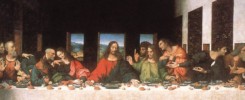This is the second volume of Amin Ramin’s “Man in Islam”. The first volume can be purchased on Amazon at this link.
The history of early Christianity is a story of rapid success, of which there are few equals. For several centuries, it grew from a marginal sect to a world religion, without the sword’s power or significant economic resources. Its adherents explain this by the “truth of Christ.” But if this were the case, it should have spread to the whole world long ago, whereas we see that Christianity has always remained the religion of the Roman Empire and the states and civilizations formed on its ruins.
Christianity began to spread in peasant Aramaic Palestine, then penetrated urban Greek-speaking Jewish circles, from them Roman cities in general, then reached the imperial court and from there began to penetrate the countryside. What is noteworthy is that at each of these stages, Christianity remained exclusively within the framework of the Roman Empire. It went beyond its borders much later, when it had already become the official religion of the Empire and enjoyed its resources and support (from there, however, it was later superseded by Islam).
And to this day, the main arena of Christianity is the successor civilizations of the Roman Empire.
Paul’s message, spreading from the eastern part of the Empire, was easier to reach its western borders than to travel to neighboring Iran, finding at least some adherents there.
And so we must look at what in the Roman Empire ensured that this religion spread so rapidly.
Rome was a city in Italy that began a series of successful wars of conquest beginning in the 3rd century BC. First, it conquered Italy, then endured three wars with Carthage, as a result of which the latter was completely defeated and destroyed. Then Rome began expanding eastward, conquering Greece, Illyria, Asia Minor, Syria, and Judea. As a result, by the first century BC, it had succeeded in uniting almost the entire civilized world under its rule.
However, the main contradiction was the lack of a universal ideology in the presence of an external unity secured by the sword. At the beginning of the Christian era, the Roman Empire was politically united but culturally and religiously fragmented. It needed a synthetic ideology that could unite disparate religions, cults, and philosophical systems around a single theme. As old ethnic, clan, and religious identities crumbled, new, universal ones had to emerge.
The common narrative that Christianity spread mainly among the poor and lower classes does not fit the facts. This legend was born out of accusations by anti-Christian polemicists who wrote that Christians recruited their followers from among the rabble, slaves, and women to undermine the social order. In reality, Christianity never turned its appeal to the “oppressed,” contrary to the “oppressors.” Its main agents were not the poor, the slaves, or the declassified, but the wealthy members of the urban “middle class.” The stronghold of the poor in antiquity was the countryside, whereas Christianity remained an exclusively urban religion until the middle of the 3rd century (and later, it would meet with considerable difficulties precisely in spreading among the peasants). It was not a revolutionary ideology or even an appeal to any particular “social justice” or “protest.” Its appeal was on a whole different level.
The Marxist theory that the spread of Christianity was a mass attempt to “flee to the afterworld” from economic hardship and political oppression is also false. The first two centuries of the Christian era were precisely a period of relative stability and prosperity under the Roman sword. At least the centuries before and after these two centuries of the dynamic spread of Christianity were far more tragic and crisis-ridden. The rapid spread of Christianity occurred during the relatively peaceful period of stabilization of the Roman Empire after a bloody era of conquest and civil wars.
The reason for its rapid success was this: the stabilization of the world Empire was accompanied by a dramatic process of identity loss among the masses within it. In this seething cauldron, hundreds and thousands of cults, beliefs, religions, philosophical systems, mystical concepts, and esoteric teachings were melting, simmering, and reacting alchemically. If you put the different ingredients in one vessel and then shake it, these ingredients will inevitably come into some kind of reaction with each other, creating a well-established mixture. The same semantic reaction was taking place in the vessel of the Roman Empire. Sooner or later, some “mixture” had to be born and established, producing a single field of meanings instead of scattered, variegated and contradictory “ingredients.” If it had not been Christianity, something else would have taken its place.
Now let us try to answer the question: Why Christianity? What ensured its victory over competing versions of synthesis?
The competing versions were, first of all, Mithraism and the cult of the emperor. The refusal to recognize the cult of the emperor was even one of the main reasons for the persecution of Christianity in the era of Domitian (81-96).
The real reason for Christianity’s rapid success was that it responded better than anyone else to a historical demand that had already been formed and was just waiting to be resolved. If the Christian cult had not done so, some other cult would have taken its place. A universal empire demanded a universal synthetic ideology. People were willing to listen to and accept such an ideology. This was the key to the rapid spread of Christianity. When its adherents claim that Christianity answers people’s questions best, they forget to mention which people. Christianity answered the questions of a specific person – the urban dweller of the Roman Empire in the first and second centuries A.D. The emergence of Christianity was not in spite of the Empire but because of it.
(And by the way, here is the answer to the Christian apologists, who claim that Islam spread “by fire and sword,” while Christianity did it exclusively by peaceful means. As a matter of fact, the political conditions for the spread of Islam were created after its ideology was approved, whereas, for Christianity, they were created before. That is, Christian ideology was a response to the political conditions. The only difference is this. Without the Roman conquests and the Roman Empire, there would never have been Christianity. The Roman Empire created “by fire and sword” a kind of “vessel,” and then Christianity filled that vessel. Naturally, it filled that vessel by peaceful means because it was a response to its formation, and already beyond it spread “by fire and sword”).
To this day, Christianity has spread primarily to the successor civilizations of the Roman Empire. Where the Roman legacy did not spread, like Iran or China, Christianity has always been something external.
So, what happened here? In the previous parts, we said that the whole variety of religions can be fit into three paradigms, into three types: prophetic Monotheism, Monism, and Dualism. What did Christianity do? It combined all three into a synthetic, highly contradictory fusion. Christianity is an inherently syncretic religion; it emerged by fusing together heterogeneous and generally incompatible traditions.
As we have said, this was due to the mash of cultures and peoples that Rome had created. Out of the combination of these three discourses, the integral religion of the Roman Empire was born, called “Christianity” (that is, “the cult of Christ”), which in reality is not so much a coherent doctrine as a very complex and contradictory semantic field, within which various currents were interwoven in a bizarre pattern. In essence, Christianity is not one religion but a conglomerate of many religions, united into a single subject, the center of which is the person of Christ.
And that was the secret of its success. It absorbed and fused into a single whole (a single story) the main traditions and logos of the Roman Empire, and the synthesis was quite convincing, at least compared to the competing versions.
At the same time, there was a struggle of different versions within Christianity itself, and it is no coincidence that the one that won was the one in which a certain balance was observed between the parts of the synthesis. The church founders intuitively sensed this: the very survival of their religion depended on whether or not such a balance could be maintained. Any unilateralism threatened to satisfy one “party” of the ancient world and antagonize the rest. And then primacy could pass to some competing cult – for example, Mithraism or the revived paganism of Emperor Julian.
For example, the Gnostic version of Christianity represented a strong bias toward Dualism. But in this case, the creationist point (which the Gnostics deliberately opposed) was totally excluded. The Origenian and Marcionite versions of Christianity emphasized Manifestationalism (Monistic paradigm). This would have caused the rejection of the Eastern bearers of the dualist principle, as well as the necessity of a complete rejection of the creationist areal from which Christ came, which would have definitively turned him into a mythical figure. And so, these versions of the Christian synthesis were declared “heresies.”
Historically, the version of Christianity that won was the one in which all three main parts of the synthesis were balanced -without any clear preponderance of one of them. Again, the “Church Fathers” intuitively felt that this synthesis could turn Christianity into a world religion. If we look at the history of the Ecumenical Councils, we see that the essence of their efforts was precisely to cut off versions that overemphasized one side of the synthesis. Such versions were branded as “heresies” and ostracized.
Thus gradually, as a result of collective efforts, a religion grew from which all the excesses that prevented its claim to worldliness were removed, and the various and even incompatible parts of the synthesis were united with one another through a sophisticated dialectic that used all the means of ancient sophistry.
In this version, Christ retained the historical appearance of a Jewish Prophet, and the Old Testament was included in the canonical books. This is the “monotheistic” component of Christianity. On the other hand, the same Christ was deified, declared to be the “son of God” and the “second person in the Trinity.” Here we see a monistic (manifestationalistic) component. Finally, the dualistic component consisted in the fact that here the world was devalued, declared “sinful” (“the world lies in wickedness”), and reality was divided into dual pairs – “earthly” and “heavenly,” “bodily” and “spiritual,” “man” and “woman”… In this way, all parties were satisfied, and Christianity became a world religion.
And so, there are also three Christian Christs. There is Christ as a Jewish Prophet. There is Christ as the monistic “son of God.” And there is Christ as the world-rejecting hero of the Black Myth. So, when we talk about the Christian Christ, we must always ask, “What kind of Christ?” There are at least three Christs superimposed on each other in the Christian arena.
This synthesis took place only once in the history of humankind, for the world Roman Empire, which created the prerequisites for it, took place only once.
886 total views


